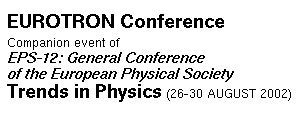 |
 |
 |
For many decades nuclear fusion research has been devoted to pursuing an almost unlimited source of energy. Thermonuclear fusion is in fact one of the very few options, potentially acceptable from the environmental, safety and economic points of view, for providing energy over the long term, which is able to support a growing world population and a move away from consuming fossil fuels. World-wide research efforts have brought the leading programmes to the threshold of conditions that might be expected in a fusion reactor. Advances in understanding in microscopic turbulence affecting energy confinement as well as macroscopic stability affecting plasma pressure have arisen from a range of smaller experiments. These developments together with the development of necessary fusion technologies have brought the global fusion programme to a level of knowledge that allows it now to address the challenge of exploring the physics of a burning plasma in an experimental device incorporating all the key features of fusion technology in reactor-relevant conditions and thus demonstrating the scientific and technological feasibility of fusion power for peaceful purposes. ITER was conceived to meet this objective.
The history of co-operation on ITER began in the mid 80ís when government leaders in summit meetings called for more substantial international co-operation in order to increase the efficiency and minimize the cost of fusion power development. After a decade of focused work, both in engineering and in physics, the ITER Engineering Design Activities (EDA) led to a design that gives confidence in the achievement of its technical objectives and in demonstrating the environmental attractiveness of fusion.
The success of the ITER EDA demonstrates feasibility and underlines the desirability of jointly implementing ITER in a broad-based international collaborative frame. It supports the ITER Parties' declared policy to pursue the development of fusion through international collaboration. Their entry into negotiations on a Joint Implementing Agreement for ITER construction and operation, which will fix the site, choose the Director-General, and determine their financial and technical share of each Party, is a very positive step in their commitment to the implementation of this policy. Given the expected success of these negotiations, a new era is opening in which fusion laboratories will have more dependable external support where they follow programmes focused on the immediate needs of developing fusion as an energy source.
This paper clarifies the above remarks, offers an outlook of the main issues of fusion plasma physics, and covers the principal features of the ITER design in relation to the groundwork it is expected to cover along the path to developing a viable and attractive source of power generation.
The following files are available:
- abstractbarabaschi.pdf [9511 bytes]
- abstractbarabaschi.doc [39936 bytes]
Eurotron Conference is supported by European Commission, High-Level Scientific Conferences